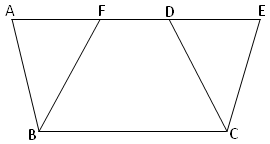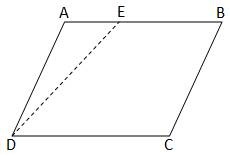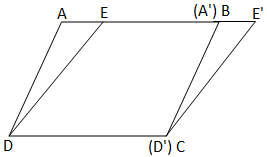Subscribe to our ▶️ YouTube channel 🔴 for the latest videos, updates, and tips.
Parallelograms on Same Base and between Same Parallels
Parallelograms on same base and between same parallels have same area.
|
In the adjoining figure, ABCD and BCEF are the two parallelograms on the same base BC and between the parallels BC and AE. |
Therefore, area of parallelogram ABCD = Area of parallelogram BCEF.
Explanation:
Draw a parallelogram ABCD on a thick sheet of paper or a cardboard sheet.
Now, draw a line segment DE as shown in the figure.
Next, cut a triangle A’D’E’ congruent to triangle ADE in a separate sheet with the help of a tracing paper and place ∆ A’D’E’ in such a way that A’D’ coincides with BC as shown in adjoining figure.
Note that there are two parallelograms ABCD and EE’CD on the same base DC and between the same parallels AE’ and DC. What can you say about their areas?
As ∆ADE ≅ ∆ A’ D’ E’
Therefore Area (ADE) = Area (A’ D’ E’)
Also Area (ABCD) = Area (ADE) + Area (EBCD)
= Area (A’D’E’) + Area (EBCD)
= Area (EE’CD)
So, the two parallelograms are equal in area.
Solved Example:
Parallelograms ABCD and ABEF are situated on the opposite sides of AB in such a way that D, A, F are not collinear. Prove that DCEF is a parallelogram, and parallelogram ABCD + parallelogram ABEF = parallelogram DCEF.
Construction: D, F and C, E are joined.
Proof: AB and DC are two opposite sides of parallelogram ABCD,
Therefore, AB ∥ DC and AB = DC
Again, AB and EF are two opposite sides of parallelogram ABEF
Therefore, AB ∥ EF and AB ∥ EF
Therefore, DC ∥ EF and DC = EF
Therefore, DCEF is a parallelogram.
Therefore, ∆ADF and ∆BCE, we get
AD = BC (opposite sides of parallelogram ABCD)
AF = BE (opposite sides of parallelogram ABEF)
And DF = CE (opposite sides of parallelogram CDEF)
Therefore, ∆ADF ≅ ∆BCE (side – side – side)
Therefore, ∆ADF = ∆BCE
Therefore, polygon AFECD - ∆BCE = polygon AFCED - ∆ADF
Parallelogram ABCD + Parallelogram ABEF = Parallelogram DCEF
Figure on Same Base and between Same Parallels
Parallelograms on Same Base and between Same Parallels
Parallelograms and Rectangles on Same Base and between Same Parallels
Triangle and Parallelogram on Same Base and between Same Parallels
Triangle on Same Base and between Same Parallels
8th Grade Math Practice
From Parallelograms on Same Base and between Same Parallels to HOME PAGE
Didn't find what you were looking for? Or want to know more information about Math Only Math. Use this Google Search to find what you need.






New! Comments
Have your say about what you just read! Leave me a comment in the box below. Ask a Question or Answer a Question.